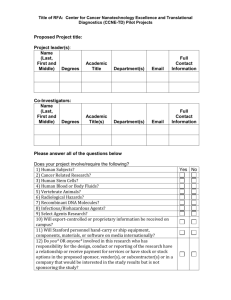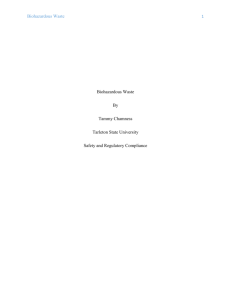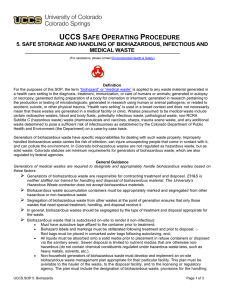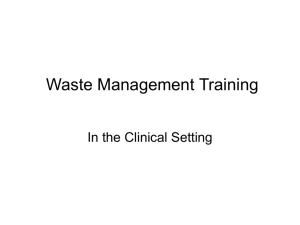Lab Safety, BIO 151
advertisement
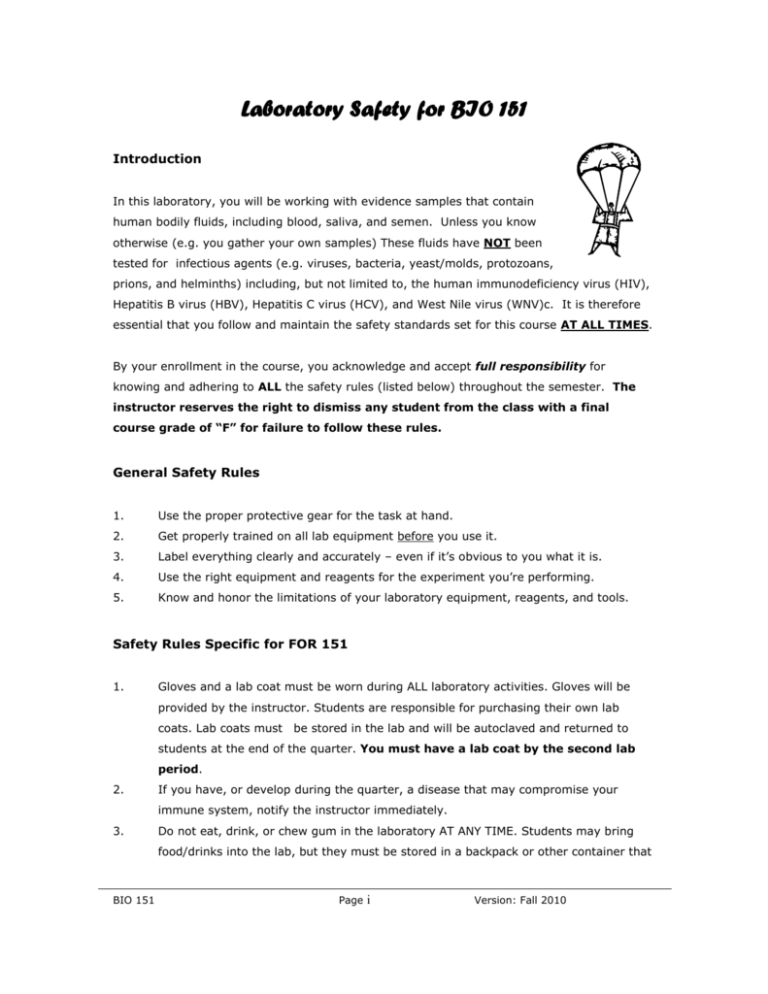
Laboratory Safety for BIO 151 Introduction In this laboratory, you will be working with evidence samples that contain human bodily fluids, including blood, saliva, and semen. Unless you know otherwise (e.g. you gather your own samples) These fluids have NOT been tested for infectious agents (e.g. viruses, bacteria, yeast/molds, protozoans, prions, and helminths) including, but not limited to, the human immunodeficiency virus (HIV), Hepatitis B virus (HBV), Hepatitis C virus (HCV), and West Nile virus (WNV)c. It is therefore essential that you follow and maintain the safety standards set for this course AT ALL TIMES. By your enrollment in the course, you acknowledge and accept full responsibility for knowing and adhering to ALL the safety rules (listed below) throughout the semester. The instructor reserves the right to dismiss any student from the class with a final course grade of “F” for failure to follow these rules. General Safety Rules 1. Use the proper protective gear for the task at hand. 2. Get properly trained on all lab equipment before you use it. 3. Label everything clearly and accurately – even if it’s obvious to you what it is. 4. Use the right equipment and reagents for the experiment you’re performing. 5. Know and honor the limitations of your laboratory equipment, reagents, and tools. Safety Rules Specific for FOR 151 1. Gloves and a lab coat must be worn during ALL laboratory activities. Gloves will be provided by the instructor. Students are responsible for purchasing their own lab coats. Lab coats must be stored in the lab and will be autoclaved and returned to students at the end of the quarter. You must have a lab coat by the second lab period. 2. If you have, or develop during the quarter, a disease that may compromise your immune system, notify the instructor immediately. 3. Do not eat, drink, or chew gum in the laboratory AT ANY TIME. Students may bring food/drinks into the lab, but they must be stored in a backpack or other container that BIO 151 Page i Version: Fall 2010 can be zipped shut or sealed. Students may eat or drink in the hallway during breaks in the lab exercises. However, students should ALWAYS wash their hands before eating or drinking if they have just completed a lab exercise. 4. Do not handle contact lenses or apply cosmetics in the laboratory. 5. Closed toed shoes must be worn in the laboratory. High heeled shoes are discouraged. 6. Carefully perform experiments to minimize aerosols and splashes. 7. Tie back long hair during laboratory experiments. 8. All items that have come into contact with bodily fluids (other than the evidentiary materials themselves, which will be saved and returned to the evidence kit) should be discarded in one of the biohazard containers. Items that have come into contact with human blood and tissues should NEVER be discarded in the regular trash. 9. Label all reagents you make with the contents, the date, and your group’s lab bench numbers –e.g. “5 M NaCl, 6/29/09, #2/7.” 10. Read the lab exercise BEFORE coming to class. Write up your protocols in your laboratory notebook before beginning any laboratory exercise. NEVER perform an experiment “on the fly.” 11. Use extreme caution when using glass items or sharp objects (e.g. scalpels). Most injuries involving biohazardous samples occur when an analyst is sampling a stain using a scalpel or pair of scissors. Pay close attention when you are using a sharp implement to cut out a biological sample. Discard all sharps in one of the properly designated sharps containers. Glass and sharp items are NEVER to be placed in the regular trash. 12. If glassware is broken, notify the instructor immediately. Broken glass should be cleaned up using a broom and dustpan and discarded in one of the properly designated sharps containers. 13. Immediately notify the instructor in the event of any injury or accident. 14. If your skin comes into direct contact with blood or other bodily fluids, notify the instructor immediately so that appropriate action can be taken. 15. Know the locations of the safety equipment in the laboratory including the fire extinguisher, eye wash station, first aid kit, and emergency telephone. Do not block access to these items. 16. Wash your hands before leaving the laboratory. 17. Do not bring visitors into the laboratory. 18. Biohazardous waste is any organism, or its toxins, that can cause disease in animals or humans or cause significant environmental or agricultural impact. Biohazardous waste is produced by living organisms and can cause damage to other biological organisms. Most biohazardous waste can be neutralized with bleach or by autoclaving. BIO 151 Page ii Version: Fall 2010 Chemical waste is waste made from harmful chemicals. It is non-living and cannot usually be neutralized by bleach or autoclaving (either of which might actually do more harm than good). Chemical waste is hazardous to humans and/or the environment and should be segregated from biohazardous waste. Each type of chemical waste is subject to different neutralization procedures and so must be collected separately from other types of chemical waste. In this lab, you must ALWAYS follow the correct procedures for disposing of both biohazardous and chemical waste. These protocols are embedded in the lab exercises and you should pay careful attention to them. PLEASE ASK IF YOU ARE UNSURE HOW TO DISPOSE OF AN ITEM. It is far better to “play it safe” than to make an error that may have serious health consequences. BIO 151 Page iii Version: Fall 2010
